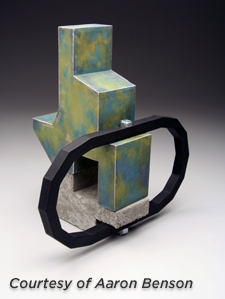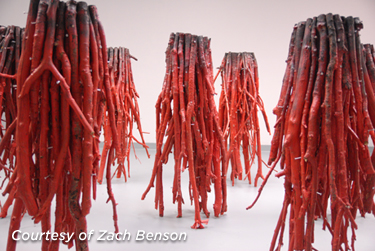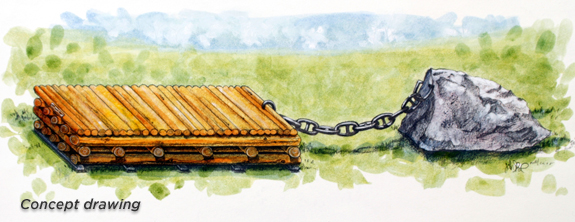Artist Lee Benson (BFA, ’84; BS, ’86; MFA, ’90) remembers when his sons, Aaron (BFA, ’09) and Zach (BFA, ’11), used to play with the wood and clay in his studio. Now, more than a decade later, the three men are collaborating on their first professional project as a team—a public piece to commemorate the effects of the 2010 flooding in Nashville.
Through this April, Lee, Aaron, and Zach will be working on their contribution to the Watermarks Project, a multi-site installation sponsored by the Metro Nashville Arts Commission that recognizes the impact of and citizen response to the floods. They have decided on a concept for the piece, though the work will not actually be finished until April 2013.
The Nashville project is the latest in a long string of public commissions that Lee, currently chair of the art department at Union University, has completed over the years, and he credits the sculpture faculty at UT with preparing him for a career in the fine arts that also enables him to enrich local communities.
“The professors and graduate students were out there making large-scale public works, and as a young person, I was enamored with that way of life,” Lee says. “The faculty taught me how to be an artist, not just make art—which are two very different things.”
Lee’s first large commission was for the Alabama School for the Deaf and Blind, where he was tasked with creating artwork for the students. He made a ring of sixty stones; each senior could select a stone, engrave it, and give it to the school as a gift. The stones would then be replaced with new ones for next year’s class.
The Alabama piece illustrates several themes of Lee’s artistic philosophy: incorporating the surrounding landscape into the work, inspiring an active viewing experience, and keeping a particular work fresh and interesting over time.
“I think the main thing that keeps recurring in my thought process is the longevity of the work,” he says. “Very few outdoor public works last more than fifty years; nature takes its course and they break down. And some works become dated visually. So when I’m thinking about what to make, I ask myself whether something will still look contemporary fifty years from now, or whether it’ll be breaking down and out of place.”
Family Legacy
Lee’s artistic legacy is not preserved solely through his work. It also can be found in Aaron and Zach, who have been involved in the art world since they were toddlers.
 “My sons were trained in how to be artists from day one,” Lee says. “They associated the studio and UT with the playground. While I worked, they’d play with art materials. So they naturally grew up with an affinity toward art. Now they realize it’s hard work, but I think those initial early years of thinking of the studio as a place to play with wood and steel and clay created a natural inclination to move into the arts.”
“My sons were trained in how to be artists from day one,” Lee says. “They associated the studio and UT with the playground. While I worked, they’d play with art materials. So they naturally grew up with an affinity toward art. Now they realize it’s hard work, but I think those initial early years of thinking of the studio as a place to play with wood and steel and clay created a natural inclination to move into the arts.”
Aaron is currently a first-year graduate student in the MFA program at Alfred University in New York, while Zach is enrolled in a postbaccalaureate program at the University of Colorado at Boulder. While all three Bensons agree that the sons have inherited their father’s work ethic, they are quick to note that Aaron and Zach are very different artistically from their father, with Lee noting that his sons are “very much their own people when it comes to creating.”
Aaron’s specialty is ceramics, particularly small-scale individual pieces. He says his work intends to reflect the security that people find in objects, and he likes to add elements to the pieces that throw the creations slightly off balance, suggesting an “uneasiness or doubt” surrounding the viewer’s assumptions about the work, or about structure and architecture as a whole.
“I reference architecture a lot in my work,” Aaron says. “My dad’s work has fluid and moving lines, but my work at the moment is rigid and hard-edged. Maybe that’s my personality coming through.”
Zach, like his father, creates large-scale sculpture, though Zach focuses on repurposed found materials in order to reclaim space and refocus the viewer’s experience.
 “I like making large-scale works because viewers can come into contact with them,” Zach says. “If you have a sculpture in a public park, it transforms the park into a new experience. If people who’ve been in the park many times visit when that sculpture is there, they’ll have a new experience when they encounter that sculpture and see the space with that work in it.”
“I like making large-scale works because viewers can come into contact with them,” Zach says. “If you have a sculpture in a public park, it transforms the park into a new experience. If people who’ve been in the park many times visit when that sculpture is there, they’ll have a new experience when they encounter that sculpture and see the space with that work in it.”
Zach and Aaron say the various residencies and internships they have completed have helped them develop individually as artists and professionals. After graduating from UT, Aaron was awarded a fully funded fellowship at the prestigious Archie Bray Foundation in Montana. In 2011 Zach completed residencies at the Anderson Center in Red Wing, Minnesota, and the Prairie Center of the Arts in Peoria, Illinois. This summer, the young men hope to join their father to work on the Watermarks Project.
“Our years at UT were important skill-building times for me and my brother,” Aaron says. “We started working individually, getting our own internships and residencies, and we became our own artists. Now my brother and I are out of college, and all three of us have our independent careers, but we’re looking forward to coming together and working as professionals on this project.”

